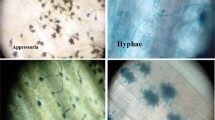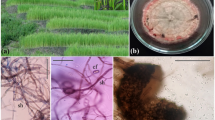Abstract
Melanins are pigments produced by a broad variety of microorganisms including some pathogenic fungi and bacteria. This study was undertaken to isolate and identify a black pigment produced by Rhizoctonia solani, the causal agent of rice sheath blight. The profile of transmission electron microscopy showed that the cell walls of the rind tissue from black sclerotia were heavily pigmented. The black pigment was designated as Rs-melanin based on the physical and chemical properties, including its ultraviolet (UV) and infrared (IR) spectra. The physical and chemical characteristics of Rs-melanin were similar to those of commercial synthetic melanin. The effects of physical and chemical factors on the stability of Rs-melanin were examined. Results indicated that Rs-melanin was greatly affected by pH values, and bleached by strong oxidant. Precursors (shikimic acid and catechol) and inhibitors (tricyclazole and kojic acid) of the four biosynthetic pathways of known melanins were tested for their ability to promote or inhibit the synthesis of Rs-melanin. Catechol, an intermediate of the catechol pathway, was found to induce Rs-melanin deposition in the hyphal walls of R. solani when the tested strain was cultured on catechol-amended medium, suggesting that Rs-melanin was a kind of catechol melanin.









Similar content being viewed by others
References
Banniza, S., & Holderness, M. (2001). Rice sheath blight—pathogen biology and diversity. In S. Sreenivasaprasad (Ed.), Major fungal diseases of rice (pp. 201–211). Dordrecht: Springer.
Bassam, S. E., Benhamou, N., & Carisse, O. (2002). The role of melanin in the antagonistic interaction between the apple scab pathogen Venturia inaequalis and Microsphaeropsis ochracea. Canadian Journal of Microbiology, 48(4), 349–358.
Bell, A. A., & Wheeler, M. H. (1986). Biosynthesis and functions of fungal melanins. Annual Review of Phytopathology, 24(1), 411–451.
Beute, M. K., & Rodriguez-Kabana, R. (1981). Effects of soil moisture, temperature, and field environment on survival of Sclerotium rolfsii in Alabama and North Carolina. Phytopathology, 71(12), 1293–1296.
Butler, M. J., & Day, A. W. (1998). Fungal melanins: a review. Canadian Journal of Microbiology, 44(12), 1115–1136.
Butler, M. J., Day, A. W., Henson, J. M., & Money, N. P. (2001). Pathogenic properties of fungal melanins. Mycologia, 93, 1–8.
Butler, M. J., Gardiner, R. B., & Day, A. W. (2009). Melanin synthesis by Sclerotinia sclerotiorum. Mycologia, 101(3), 296–304.
Carling, D. E. (1996). Grouping in Rhizoctonia solani by hyphal anastomosis reaction. In B. Sneh, S. Jabaji-Hare, S. Neate, & G. Dijst (Eds.), Rhizoctonia species: taxonomy, molecular biology, ecology, pathology and disease control (pp. 37–47). The Netherlands: Springer.
Cubeta, M. A., & Vilgalys, R. (1997). Population biology of the Rhizoctonia solani complex. Phytopathology, 87(4), 480–484.
De Jong, J. C., McCormack, B. J., Smirnoff, N., & Talbot, N. J. (1997). Glycerol generates turgor in rice blast. Nature, 389(6648), 244–244.
Elliott, M. L. (1995). Effect of melanin biosynthesis inhibiting compounds on Gaeumannomyces species. Mycologia, 87, 370–374.
Ellis, D. H., & Griffiths, D. A. (1974). The location and analysis of melanins in the cell walls of some soil fungi. Canadian Journal of Microbiology, 20(10), 1379–1386.
Harki, E., Talou, T., & Dargent, R. (1997). Purification, characterisation and analysis of melanin extracted from Tuber melanosporum Vitt. Food Chemistry, 58(1), 69–73.
Henis, Y., & Papavizas, G. C. (1983). Factors affecting germinability and susceptibility to attack of sclerotia of Sclerotium rolfsii by Trichoderma harzianum in field soil. Phytopathology, 73(10), 1469–1474.
Huang, H. C., & Kokko, E. G. (1989). Effect of temperature on melanization and myceliogenic germination of sclerotia of Sclerotinia sclerotiorum. Canadian Journal of Botany, 67, 1387–1394.
Hyakumachi, M., Yokoyama, K., & Ui, T. (1987). Role of melanin in susceptibility and resistance of Rhizoctonia solani to microbial lysis. Transactions of the British Mycological Society, 89(1), 27–33.
Kawamura, C., Tsujimoto, T., & Tsuger, T. (1999). Targeted disruption of a melanin biosynthesis gene affects conidial development and UV tolerance in the Japanese pear pathotype of Alternaria alternata. Molecular Plant-Microbe Interactions, 12, 59–63.
Kim, H. T., Chung, Y. R., & Cho, K. Y. (2001). Mycelial melanization of Rhizoctonia solani AG1 affecting pathogenicity in rice. Plant Pathology Journal, 17, 210–215.
Kubo, Y., & Furusawa, I. (1991). Melanin biosynthesis: Pre-requisite for successful invasion of the plant host by appressoria of Colletotrichum and Pyricularia. In Cole, G.T., Hoch, H.C. (Eds.), The Fungal Spore and Disease Initiation in Plants and Animals (pp. 205–217). Plenum Publishing Corporation, New York - London.
Merriman, P. R. (1976). Survival of sclerotia of Sclerotinia sclerotiorum in soil. Soil Biology and Biochemistry, 8(5), 385–389.
Money, N. P., & Howard, R. J. (1996). Confirmation of a link between fungal pigmentation, turgor pressure, and pathogenicity using a new method of turgor measurement. Fungal Genetics and Biology, 20(3), 217–227.
Paim, S., Linhares, L. F., Mangrich, A. S., & Martin, J. P. (1990). Characterization of fungal melanins and soil humic acids by chemical analysis and infrared spectroscopy. Biology and Fertility of Soils, 10(1), 72–76.
Paranjpe, M. S., Chen, P. K., & Jong, S. C. (1978). Phenolic and other organic-compounds in morphologically different tissues of Agaricus bisporus. Transactions of the Mycological Society of Japan, 19(2), 169–180.
Piattelli, M., Fattorusso, E., Magno, S., & Nicolaus, R. A. (1963). Ustilago melanin, a naturally occurring catechol melanin. Tetrahedron Letters, 4(15), 997–998.
Prota, G. (1992). Melanins and melanogenesis. Academic Press, New York, pp. 1–290.
Rast, D.M., Stussis, H., Hegnauer, H., & Nylilen, L.E. (1981). Melanins. In Turian, G., Hohl, H.R. (Eds,). The fungal Spore: Morphogenetic Controls (pp. 507–531). Academic Press, London – New York.
Shivprasad, S., & Page, W. J. (1989). Catechol formation and melanization by Na+-dependent Azotobacter chroococcum: a protective mechanism for aeroadaptation? Applied and Environmental Microbiology, 55(7), 1811–1817.
Strauss, E. E., Lakshman, D. K., & Tavantzis, S. M. (2000). Molecular characterization of the genome of a partitivirus from the basidiomycete Rhizoctonia solani. Journal of General Virology, 81(2), 549–555.
Taheri, P., & Tarighi, S. (2011). Cytomolecular aspects of rice sheath blight caused by Rhizoctonia solani. European Journal of Plant Pathology, 129(4), 511–528.
Tolmsoff, W. J., Bell, A. A., & Wheeler, M. H. (1975). Pigment formation from artificial substrates by albino microsclerotia of Verticillium dahliae in relation to melanin synthesis. In Proceedings of the Beltwide Cotton Production Research Conference, pp. 27–28. National Cotton Council of America, Cordova, TN, USA.
Townsend, B. B. (1957). Nutritional factors influencing the production of sclerotia by certain fungi. Annals of Botany, 21(1), 153–166.
Vidhyasekaran, P., Ponmalar, T. R., Samiyappan, R., Velazhahan, R., Vimala, R.,d Ramanathan, A., & Muthukrishnan, S. (1997). Host-specific toxin production by Rhizoctonia solani, the rice sheath blight pathogen. Phytopathology, 87(12), 1258–1263.
Wang, Y., & Casadevall, A. (1994). Decreased susceptibility of melanized Cryptococcus neoformans to UV light. Applied and Environmental Microbiology, 60(10), 3864–3866.
Wheeler, M. H., Bruton, B. D., Puckhaber, L. S., Zhang, J., & Stipanovic, R. D. (2004). Identification of 1, 8-dihydroxynaphthalene melanin in Monosporascus cannonballus and the analysis of hexaketide and pentaketide compounds produced by wild-type and pigmented isolates of the fungus. Journal of Agricultural and Food Chemistry, 52(13), 4113–4120.
Yang, Y. Q., Yang, M., Li, M. H., & Zhou, E. X. (2012). Cloning and functional analysis of an endo-PG-encoding gene Rrspg1 of Rhizoctonia solani, the causal agent of rice sheath blight. Canadian Journal of Plant Pathology, 34(3), 436–447.
Acknowledgments
This work was supported by a grant from National Natural Science Foundation of China (Grant No. 31271994) awarded to Erxun Zhou. The authors are grateful to the China National Analytical Center, Guangzhou, China for its technical assistance and infrared spectroscopy facility support.
Author information
Authors and Affiliations
Corresponding author
Rights and permissions
About this article
Cite this article
Chen, J., Wang, C., Shu, C. et al. Isolation and characterization of a melanin from Rhizoctonia solani, the causal agent of rice sheath blight. Eur J Plant Pathol 142, 281–290 (2015). https://doi.org/10.1007/s10658-015-0612-0
Accepted:
Published:
Issue Date:
DOI: https://doi.org/10.1007/s10658-015-0612-0




